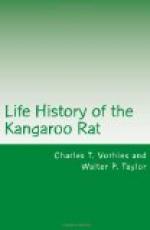For some years an intensive study of the forage and other vegetative conditions of this area has been made, the permanent vegetation quadrat, as proposed by Dr. F. E. Clements (1905, 161-175), being largely utilized. During the autumn of 1917 representatives of the Carnegie Institution and the Arizona Agricultural Experiment Station visited the Reserve and were impressed with the evidence of rodent damage to the grass cover. The most conspicuous appearance of damage was noted about the habitations of the banner-tailed kangaroo rat (Dipodomys spectabilis spectabilis Merriam), although it was observed also that jack rabbits of two species (Lepus californicus eremicus Allen and L. alleni alleni Mearns), which were very abundant in some portions of the reserve, were apparently affecting adversely the forage conditions in particular localities. Accordingly, the Biological Survey, the Agricultural Experiment Station of the University of Arizona, the Carnegie Institution of Washington, and the U. S. Forest Service have undertaken a study of the relation of the more important rodents to the forage crop of the Range Reserve in Arizona.
The present paper is a first step in this larger investigation.[2] In this work the authors have made no attempt to deal with the taxonomic side of the kangaroo rat problem. It is not unlikely that intensive studies will show that the form now known as Dipodomys spectabilis spectabilis is made up of a number of local variants, some of them perhaps worthy of recognition as additional subspecies. But it is felt that the conclusions here reached will be little, if at all, affected by such developments.
Color descriptions are based on Ridgway’s Color Standards and Color Nomenclature published in 1912.
[Footnote 1: References in parentheses are to the Bibliography, p. 40 (the last figure being to the page of the publication). References to authorities where no citation of literature is appended relate for the most part to manuscript notes in the files of the Biological Survey or the University of Arizona Agricultural Experiment Station.]
[Footnote 2: In addition to assistance rendered by officials of the Biological Survey and the University of Arizona, which is hereby acknowledged, the authors are indebted to the following persons for helpful suggestions and assistance: G. S. Miller and J. W. Gidley, of the U. S. National Museum; Dr. Frederic E. Clements and Gorm Loftfield, of the Carnegie Institution; Morgan Hebard, of the Academy of Natural Sciences of Philadelphia; James T. Jardine and R. L. Hensel, both formerly connected with the U. S. Forest Service; and R. R. Hill, of the Forest Service. They are also indebted to William Nicholson, of Continental, Ariz., for many courtesies extended in connection with work on the Reserve.]




